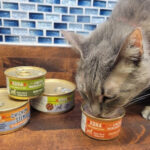Choosing the right cat food can be daunting, but determining the correct amount to feed your feline friend is equally crucial for their health and well-being. Whether you’ve just welcomed a kitten into your home or are adjusting the diet of your adult cat, understanding their nutritional needs is paramount. This guide will help you navigate the factors that influence your cat’s food intake and ensure they receive the optimal nutrition for a happy and healthy life. For personalized advice, always consult with your veterinarian, as they are best equipped to assess your cat’s individual needs.
Understanding Your Cat’s Caloric Needs
The amount of food your cat needs daily is not a one-size-fits-all answer. It depends on a variety of factors, both environmental and physiological. Age is a primary determinant – kittens, adults, and senior cats have vastly different nutritional requirements.
Key Factors Influencing Food Intake
-
Age: Kittens are in a rapid growth phase and require more calories and nutrients to support their development. They need energy for building bones, muscles, and all the systems that will support them through adulthood. Think of it like fueling a race car in its early stages.
-
Life Stage: As cats transition into adulthood (around one year old), their growth slows, and their caloric needs typically decrease. They’ve reached their full size and their metabolism adjusts.
-
Seniority: Senior cats (typically 7-8 years and older) may again require adjustments in their diet. Some seniors become less active and need fewer calories to prevent weight gain, while others might need more easily digestible food, particularly if they develop health issues common in older cats. Managing their weight is crucial to avoid stressing aging joints and exacerbating conditions like arthritis.
-
Breeding Status: Whether your cat is spayed/neutered or intact (not spayed/neutered) plays a significant role in their metabolism. Intact cats, due to their sex hormones, generally have higher metabolisms and require more calories than spayed or neutered cats. Spaying or neutering often leads to a decrease in metabolic rate, meaning less food is needed to maintain a healthy weight.
-
Pregnancy: Pregnant female cats have increased caloric demands to support the developing kittens. Their food intake needs to rise gradually throughout pregnancy to nourish both themselves and their growing litter.
Daily Food Requirements for Cats: Calories and Portions
Knowing how much to feed your cat isn’t just about portion size; it’s fundamentally about calories. Calories, often measured in kilocalories (kcal) on pet food labels (kcal is interchangeable with calories), are the units of energy your cat gets from their food.
Pet food packaging typically includes feeding guidelines and caloric content information near the ingredient list. This is usually expressed as kcal per cup for dry food or kcal per can for wet food.
To determine your cat’s daily caloric needs, consulting your veterinarian is the most accurate approach. Vets calculate this based on factors like weight (in kilograms) and body condition score – a visual and physical assessment of your cat’s body fat.
A simplified guideline suggests that adult cats need approximately 25 to 35 calories per pound of body weight daily. For instance, a 10-pound cat might need around 250 kcal per day. However, this is a general estimate.
Activity levels also significantly impact calorie needs. A highly active cat who loves to play and explore will naturally burn more calories than a less active, indoor-only cat. Less active cats are prone to weight gain if fed the same amount as a more energetic cat.
For precise feeding recommendations tailored to your cat’s unique circumstances, always seek advice from your veterinarian.
Calculating Caloric Needs: The General Rule
While veterinary guidance is paramount, understanding the general calorie rule can be helpful. Remember the 25-35 calories per pound guideline as a starting point. Observe your cat’s weight and body condition regularly and adjust intake accordingly, always in consultation with your vet.
Using Food Labels to Determine Portion Size
Once you know your cat’s daily caloric needs, deciphering food labels becomes essential. Locate the caloric content per cup or can on your cat food packaging. If your cat needs 250 kcal daily and the food is 500 kcal per cup, you’d feed them ½ cup of food per day. Divide this daily amount across meals – for twice-daily feeding, give ¼ cup at each meal.
Wet vs. Dry Food Considerations
Cats can thrive on both wet and dry food, or a combination. Caloric density differs significantly between them. Wet food generally has fewer calories per volume compared to dry food due to its higher moisture content. When feeding a mix, calculate the calories from each type to meet your cat’s total daily requirement. For example, if a cat needs 250 kcal and eats both wet and dry food, aim for 125 kcal from wet food and 125 kcal from dry food.
The Role of Treats
Treats should be given in moderation, ideally constituting no more than 10% of your cat’s daily calorie intake. Factor treat calories into the overall daily count to prevent overfeeding. If you offer treats daily, reduce their regular food portion to compensate for the extra calories.
Cat Feeding Chart: A Quick Guide
This chart provides estimated daily calorie needs for adult cats (1-7 years old). Remember, these are guidelines; individual needs vary. Always consult your veterinarian for personalized advice.
| Cat Weight | Spayed/Neutered | Intact | Healthy Cat, Prone to Obesity | In Need of Weight Loss |
|---|---|---|---|---|
| 5lbs | 125 kcal/day | 175 kcal/day | 100 kcal/day | 75 kcal/day |
| 8lbs | 200 kcal/day | 280 kcal/day | 160 kcal/day | 120 kcal/day |
| 10lbs | 250 kcal/day | 350 kcal/day | 200 kcal/day | 150 kcal/day |
| 12lbs | 300 kcal/day | 420 kcal/day | 240 kcal/day | 180 kcal/day |
| 15lbs | 375 kcal/day | 525 kcal/day | 300 kcal/day | 225 kcal/day |
| 18lbs | 450 kcal/day | 630 kcal/day | 360 kcal/day | 270 kcal/day |
| 20lbs | 500 kcal/day | 700 kcal/day | 400 kcal/day | 300 kcal/day |
To convert calories to portion sizes, check the calorie information on your specific cat food packaging and calculate accordingly. For instance, if your cat’s food is 400 kcal per cup and they need 200 kcal daily, feed them ½ cup per day.
Recognizing Overfeeding and Potential Health Risks
It’s easy to equate food with affection and inadvertently overfeed our cats. However, excessive food intake can lead to significant health problems.
Signs of Overfeeding
Watch for these signs indicating your cat might be eating too much:
-
Weight Gain: This is the most obvious sign. Regularly monitor your cat’s weight and body condition.
-
Decreased Activity: Overweight cats often become less playful and sleep more.
-
Developing Health Issues: Overfeeding contributes to various health problems.
Health Consequences of Obesity
Obesity, defined as being 20% or more above ideal body weight, is the most common nutritional disorder in domestic cats. A study highlighted that a significant percentage of cats are obese, putting them at higher risk for:
-
Diabetes: Obesity is a major risk factor for type 2 diabetes in cats.
-
Arthritis: Excess weight puts stress on joints, worsening or triggering arthritis.
-
Heart Disease: Obesity can strain the cardiovascular system.
-
Liver Disease (Hepatic Lipidosis): Overweight cats are prone to liver problems.
-
Increased Surgical and Anesthetic Risk: Anesthesia becomes riskier in obese animals.
Prioritizing proper feeding and preventing overfeeding is an act of love that significantly contributes to your cat’s long-term health and happiness. Always consult with your veterinarian to determine the ideal feeding plan for your feline companion, ensuring they receive the right amount of food to thrive.


